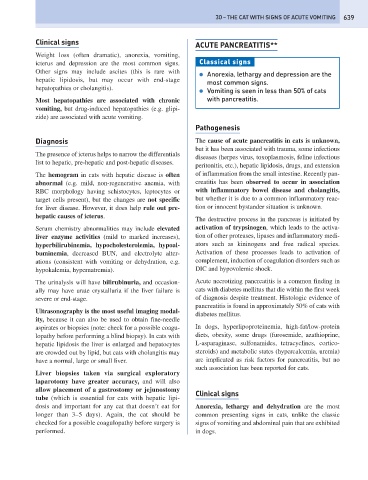Page 647 - Problem-Based Feline Medicine
P. 647
30 – THE CAT WITH SIGNS OF ACUTE VOMITING 639
Clinical signs ACUTE PANCREATITIS**
Weight loss (often dramatic), anorexia, vomiting,
icterus and depression are the most common signs. Classical signs
Other signs may include ascites (this is rare with
● Anorexia, lethargy and depression are the
hepatic lipidosis, but may occur with end-stage
most common signs.
hepatopathies or cholangitis).
● Vomiting is seen in less than 50% of cats
Most hepatopathies are associated with chronic with pancreatitis.
vomiting, but drug-induced hepatopathies (e.g. glipi-
zide) are associated with acute vomiting.
Pathogenesis
Diagnosis The cause of acute pancreatitis in cats is unknown,
but it has been associated with trauma, some infectious
The presence of icterus helps to narrow the differentials
diseases (herpes virus, toxoplasmosis, feline infectious
list to hepatic, pre-hepatic and post-hepatic diseases.
peritonitis, etc.), hepatic lipidosis, drugs, and extension
The hemogram in cats with hepatic disease is often of inflammation from the small intestine. Recently pan-
abnormal (e.g. mild, non-regenerative anemia, with creatitis has been observed to occur in association
RBC morphology having schistocytes, leptocytes or with inflammatory bowel disease and cholangitis,
target cells present), but the changes are not specific but whether it is due to a common inflammatory reac-
for liver disease. However, it does help rule out pre- tion or innocent bystander situation is unknown.
hepatic causes of icterus.
The destructive process in the pancreas is initiated by
Serum chemistry abnormalities may include elevated activation of trypsinogen, which leads to the activa-
liver enzyme activities (mild to marked increases), tion of other proteases, lipases and inflammatory medi-
hyperbilirubinemia, hypocholesterolemia, hypoal- ators such as kininogens and free radical species.
buminemia, decreased BUN, and electrolyte alter- Activation of these processes leads to activation of
ations (consistent with vomiting or dehydration, e.g. complement, induction of coagulation disorders such as
hypokalemia, hypernatremia). DIC and hypovolemic shock.
The urinalysis will have bilirubinuria, and occasion- Acute necrotizing pancreatitis is a common finding in
ally may have urate crystalluria if the liver failure is cats with diabetes mellitus that die within the first week
severe or end-stage. of diagnosis despite treatment. Histologic evidence of
pancreatitis is found in approximately 50% of cats with
Ultrasonography is the most useful imaging modal-
diabetes mellitus.
ity, because it can also be used to obtain fine-needle
aspirates or biopsies (note: check for a possible coagu- In dogs, hyperlipoproteinemia, high-fat/low-protein
lopathy before performing a blind biopsy). In cats with diets, obesity, some drugs (furosemide, azathioprine,
hepatic lipidosis the liver is enlarged and hepatocytes L-asparaginase, sulfonamides, tetracyclines, cortico-
are crowded out by lipid, but cats with cholangitis may steroids) and metabolic states (hypercalcemia, uremia)
have a normal, large or small liver. are implicated as risk factors for pancreatitis, but no
such association has been reported for cats.
Liver biopsies taken via surgical exploratory
laparotomy have greater accuracy, and will also
allow placement of a gastrostomy or jejunostomy Clinical signs
tube (which is essential for cats with hepatic lipi-
dosis and important for any cat that doesn’t eat for Anorexia, lethargy and dehydration are the most
longer than 3–5 days). Again, the cat should be common presenting signs in cats, unlike the classic
checked for a possible coagulopathy before surgery is signs of vomiting and abdominal pain that are exhibited
performed. in dogs.

